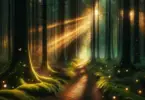
Highlighting the ribbon: The Herschel telescope sees infrared and sub-millimetre light, which can readily penetrate through the dust hovering between the bustling centre of our galaxy and us
A bizarre, twisted ring of dense gas at the centre of our Milky Way galaxy has been observed by the Herschel Space Observatory. Only a few portions of the ring, which stretches across more than 600 light-years, were known before. But Herschel’s view reveals the entire ring for the first time – and a strange kink that resembles a ribbon has astronomers scratching their heads.
[pro_ad_display_adzone id=”110028″]
Nasa researcher Alberto Noriega-Crespo, of the California Institute of Technology in Pasadena, said: ‘We have looked at this region at the centre of the Milky Way many times before in the infrared.
‘But when we looked at the high-resolution images using Herschel’s sub-millimetre wavelengths, the presence of a ring is quite clear.’
The Herschel Space Observatory is a European Space Agency-led mission with important Nasa contributions.
It sees infrared and sub-millimetre light, which can readily penetrate through the dust hovering between the bustling centre of our galaxy and us. Herschel’s detectors are also suited to see the coldest stuff in our galaxy.
When astronomers turned the giant telescope to look at the centre of the Milky Way, it captured unprecedented views of its inner ring – a dense tube of cold gas mixed with dust, where new stars are forming.
Astronomers were shocked by what they saw – the ring, which is in the plane of our galaxy, looked more like an infinity symbol with two lobes pointing to the side.
In fact, they later determined the ring was torqued in the middle, so it only appears to have two lobes. To picture the structure, imagine holding a stiff, elliptical band and twisting the ends in opposite directions, so that one side comes up a bit.
‘This is what is so exciting about launching a new space telescope like Herschel,’ said lead researcher Sergio Molinari of the Institute of Space Physics in Rome, Italy.
‘We have a new and exciting mystery on our hands, right at the centre of our own galaxy.’
Observations with the ground-based Nobeyama Radio Observatory in Japan complimented the Herschel results by determining the velocity of the denser gas in the ring.

New horizons: This bizarre, twisted ring of dense gas at the centre of our Milky Way galaxy was observed by the Herschel Space Observatory
The radio results demonstrate that the ring is moving together as a unit, at the same speed relative to the rest of the galaxy.
The ring lies at the centre of our Milky Way’s bar – a bar-shaped region of stars at the centre of its spidery spiral arms. This bar is actually inside an even larger ring.
Other galaxies have similar bars and rings. A classic example of a ring inside a bar is in the galaxy NGC 1097, imaged here by Nasa’s Spitzer Space Telescope. The ring glows brightly in the center of the galaxy’s large bar structure. It is not known if that ring has a kink or not.
The details of how bars and rings form in spiral galaxies are not well understood, but computer simulations demonstrate how gravitational interactions can produce the structures.
Some theories hold that bars arise out of gravitational interactions between galaxies. For example, the bar at the centre of the Milky Way might have been influenced by our largest neighbour galaxy, Andromeda.
The twist in the ring is not the only mystery to come out of the new Herschel observations.
Astronomers say that the centre of the torqued portion of the ring is not where the centre of the galaxy is thought to be, but slightly offset.
The centre of our galaxy is considered to be around Sagittarius A, where a massive black hole lies.
According to Dr Noriega-Crespo, it’s not clear why the centre of the ring doesn’t match up with the assumed centre of our galaxy.
‘There’s still so much about our galaxy to discover,’ he said.
The study is published in Astrophysical Journal Letters.
[pro_ad_display_adzone id=”110027″]






